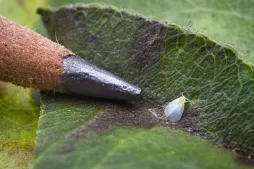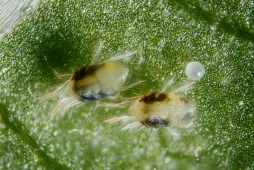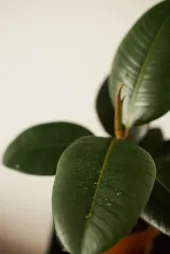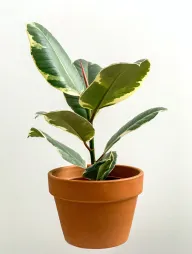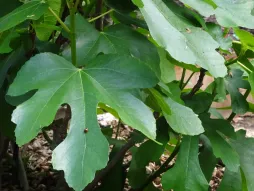Ficus lyrata, the lyre-leaved fig tree
Looking for a majestic tree to grace your living room? Choose a Ficus lyrata. With its tall stature and immense leaves, the lyre fig is a real eye-catcher. This shrub from the Moraceae family comes to us from West Africa. But it loves the warmth of our homes.
How to recognize Ficus lyrata, the lyre fig?
Ficus lyrata is an upright, weakly branched tree. In the wild, it reaches heights of over twelve meters. In pots and indoors, it is content to grow to a height of three meters, with a spread of less than one meter.
The lyre fig has a trunk with brown, almost red bark. Over time, the bark lightens and turns gray.
The leaves, reminiscent of a violin or lyre, give the tree its name. Coriaceous and glossy, they are wavy with prominent veins. The deep-green leaf blades are plain. If you're looking for a variegated variety, choose Ficus benjamina or Ficus elastica.
In our latitudes, Ficus lyrata is grown solely for its evergreen foliage. The wasp responsible for pollination lives only in West Africa. Thanks to this wasp, the tree produces fruit in spring , which contains the flowers.
If you enjoy the figs offered by ficus carica, you'd be better off not tasting the leaves of Ficus lyrata. The leaf blades are toxic when ingested. The plant also contains latex, a substance that is irritating to the skin and mucous membranes. Remember to wear gloves when pruning and repotting your specimen. Keep your shrub out of the reach of small children and pets.
Our maintenance tips
Ficus lyrata don't like change. Once yours has been installed away from draughts, don't move it again. It could lose its leaves.
Watering
Ficus lyrata needs a regular supply of water. But, like many plants, the plant cannot tolerate excess. Check that the potting soil has dried on the surface (two to three centimetres) before watering. If this is the case, use non-calcareous water at room temperature. You only need to moisten the root ball, not the soil.
Don't forget to drain off any stagnant water in the saucer or planter. It could rot the roots.
Spray
Spray foliage with non-calcareous water at room temperature. In addition to increasing humidity, misting prevents the appearance of undesirable insects.
Repotting
Every spring, repot your Ficus lyrata to give it more space.
In a drilled pot, place a layer of clay balls or gravel to promote drainage. The pot should be deeper and larger than the previous one to accommodate the roots and support the growth of your ficus lyrata.
Choose a special potting soil for green plants or houseplants. After pouring in the substrate, plant your plant. Fill in with soil and tamp down to eliminate any air pockets.
Fertilization
To promote the growth of your Ficus lyrata, apply fertilizer in spring and summer.
Apply a liquid fertilizer for green plants to stimulate growth.
Cleaning
When the foliage of your Lyre fig is covered with dust, the photosynthesis process is slowed down. To allow the plant to take full advantage of the light, gently wipe the leaves with a clean, damp cloth.
To avoid damaging the largest limbs, support them with one hand while you wash them with the other.
Prune
Trim your Ficus lyrata, whatever its size, to make it denser. Use a clean, sharp tool. Shorten each branch by at least five centimetres, cutting above a healthy leaf. Remove dead branches too.
Caution! Sap is toxic. Wear gloves for protection.
Plantation
When the risk of frost has passed, it's time to plant.
Choose a location in the sun and sheltered from the wind. Soak the root ball of your Lyre fig while you prepare the soil.
Dig a hole twice the size of the root ball. Take the opportunity to work the soil. Remove stones, weeds and plant waste.
Plant your plant in the center. The top of the rootball should be level with the ground. Fill in with garden soil. You can add potting soil or compost to enrich the soil. Tamp lightly and water to eliminate air bubbles.
Mulch the soil to retain moisture and reduce evaporation.
Cutting
Cutting is carried out during the strong growth phase, generally in spring and early summer.
Select a stem without flowers or flower buds. Using clean pruning shears, cut a fifteen-centimeter section.
Slash the base vertically with a disinfected cutter to increase the rooting surface. You can dip this end in cuttings hormone.
Remove the lower leaves and keep only the terminal pair.
Immerse the lower part of your cutting inclear water at room temperature. Make sure the level remains even and the liquid clean.
Protect your cutting from direct sunlight.
Protect your cutting from direct sunlight.
Diseases / Threats
Information
| Family | Moraceae - Moraceae |
| Type | Ficus - Ficus |
| Species | Lyre fig - Ficus lyrata |
| Lifecycle | Perennial |
| Foliage | Evergreen |
| Exposures | |
| Substrats | |
| Planting methods |
Open ground In pots In tubs |
| Categories | |
| Tags |
Fritillary Large pot Toxic |
| Origin |
West Africa |
| Hardiness (USDA) | 11a |
| Leaf color |
|
| Flower color |
|
| Fruit color |
|
Discover plants from the same family














